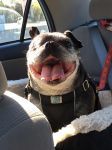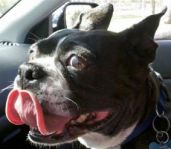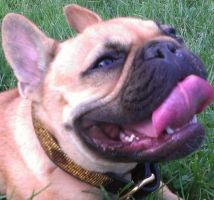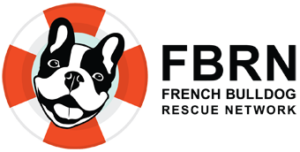Brachycephalic Airway Syndrome (BAS)
 That’s a great big mouthful, but if you have a French bulldog or any smoosh-faced breed, you should know about it. We’ve lost more than a few fosters and grads to BAS, and if you get a group of 20 bulldog and pug owners together, you will hear at least a half dozen stories of close calls. What is it?
That’s a great big mouthful, but if you have a French bulldog or any smoosh-faced breed, you should know about it. We’ve lost more than a few fosters and grads to BAS, and if you get a group of 20 bulldog and pug owners together, you will hear at least a half dozen stories of close calls. What is it?
BAS is a constellation of problems in smoosh-faced dogs, including very narrow nostrils (stenotic nares) that make breathing through the nose difficult or impossible; an elongated soft palate that partially covers the opening of the trachea; a narrower trachea than usual; and sacs inside the voicebox or larynx that get pulled into the airway with the effort of inhalation, narrowing the airway further and making breathing harder than it is for their snootier dog friends who have shorter soft palates and more open nostrils, the better to take in air and to cool the air they do take in.
Though some Frenchies don’t make any breathing sounds, many Frenchie owners are familiar with the grunting, snorting, snoring sounds Frenchies make while awake or asleep. Many of us get so used to it, the sounds are a comforting background noise, but owners should be aware those noises may indicate one or more of the symptoms of BAS. Some dogs are so seriously affected they can’t exercise much, or they vomit or cough after exercise or exertion. Heat and humidity makes their symptoms much worse.
BAS puts strain on the heart so that, eventually, exertion of any kind is  exhausting, and BAS can also cause laryngeal collapse, which will mean near total or total obstruction of airflow. Some dogs live with a tracheostomy after a laryngeal collapse, but as you can imagine, caring for a dog with a tracheostomy can be difficult and even stressful, and for many dogs the prognosis for a long life with a tracheostomy is poor. Dogs with allergies on top of limited airflow may have an even greater likelihood of long-term damage to the airway and possible laryngeal collapse. One of our volunteers has a dog that had surgery to correct what could be corrected, but nothing could be done for the very narrow trachea her dog was born with. Her vet explained that breathing for her dog felt similar to what it would feel like for a human to run while trying to breathe through a straw.
exhausting, and BAS can also cause laryngeal collapse, which will mean near total or total obstruction of airflow. Some dogs live with a tracheostomy after a laryngeal collapse, but as you can imagine, caring for a dog with a tracheostomy can be difficult and even stressful, and for many dogs the prognosis for a long life with a tracheostomy is poor. Dogs with allergies on top of limited airflow may have an even greater likelihood of long-term damage to the airway and possible laryngeal collapse. One of our volunteers has a dog that had surgery to correct what could be corrected, but nothing could be done for the very narrow trachea her dog was born with. Her vet explained that breathing for her dog felt similar to what it would feel like for a human to run while trying to breathe through a straw.
Owners usually discover that their dogs are having an unusually hard time breathing when their dog is younger than 3, and the best treatment for moderate to severe BAS is surgery. If you read our available dog bios often, you will have read that this or that dog had his nares (nostrils) widened or his soft palate reduced or shortened. Our available dog, Wren, has BAS. If your dog has BAS, you should avoid taking him on any more than a short walk in temperatures over 75 degrees and never in the full sun or on especially humid days—let him stay home in the air conditioning. Keep your dog’s weight down to the point that you can’t see his ribs, but you can feel them if you run your hands over them. You should not allow your dog to get stressed or excited.
 Don’t be complacent about your smoosh-faced dog. The fact that your Frenchie has never made those sounds is not a guarantee that your dog won’t develop symptoms. If you have a Frenchie who has never shown signs of BAS—he’s never made those snorty noises or seemed to have any problems exercising—but one sunny day while you are having a picnic or you are watching a softball game or you are on a hike and he starts panting heavily, maybe coughing or vomiting, get him to the nearest water you can and run it over his tummy. While you are doing that, find the nearest vet. If your dog doesn’t recover quickly or if he is blowing mucus or coughing, pile everybody and the dog in the car and zippy over to have him put in an oxygen crate. There’s a good example of just this sort of thing happening and what Cosette’s mom did to save her life.https://fbrnetworknews.blogspot.com/…ating-and.html
Don’t be complacent about your smoosh-faced dog. The fact that your Frenchie has never made those sounds is not a guarantee that your dog won’t develop symptoms. If you have a Frenchie who has never shown signs of BAS—he’s never made those snorty noises or seemed to have any problems exercising—but one sunny day while you are having a picnic or you are watching a softball game or you are on a hike and he starts panting heavily, maybe coughing or vomiting, get him to the nearest water you can and run it over his tummy. While you are doing that, find the nearest vet. If your dog doesn’t recover quickly or if he is blowing mucus or coughing, pile everybody and the dog in the car and zippy over to have him put in an oxygen crate. There’s a good example of just this sort of thing happening and what Cosette’s mom did to save her life.https://fbrnetworknews.blogspot.com/…ating-and.html
Not every smoosh-faced dog will show signs of BAS. But virtually every  smoosh-faced dog is at risk of panting too hard on a hot day and causing the airway to swell. The photos accompanying this piece were provided by knowledgeable Frenchie owners in response to a request for photos of what a too-hot dog looks like. When your dog looks like the dogs here, it’s time to take 5 and cool off.
smoosh-faced dog is at risk of panting too hard on a hot day and causing the airway to swell. The photos accompanying this piece were provided by knowledgeable Frenchie owners in response to a request for photos of what a too-hot dog looks like. When your dog looks like the dogs here, it’s time to take 5 and cool off.

